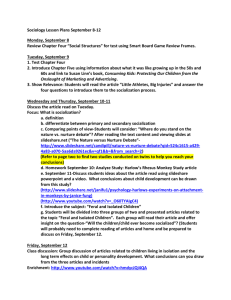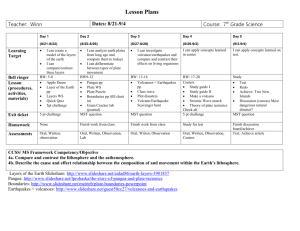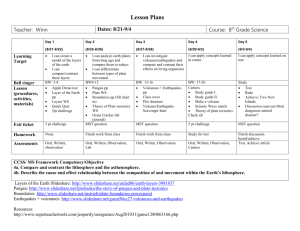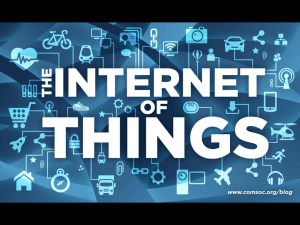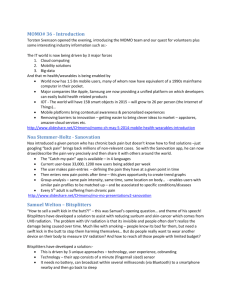Technology Training that Works Technology Training
advertisement
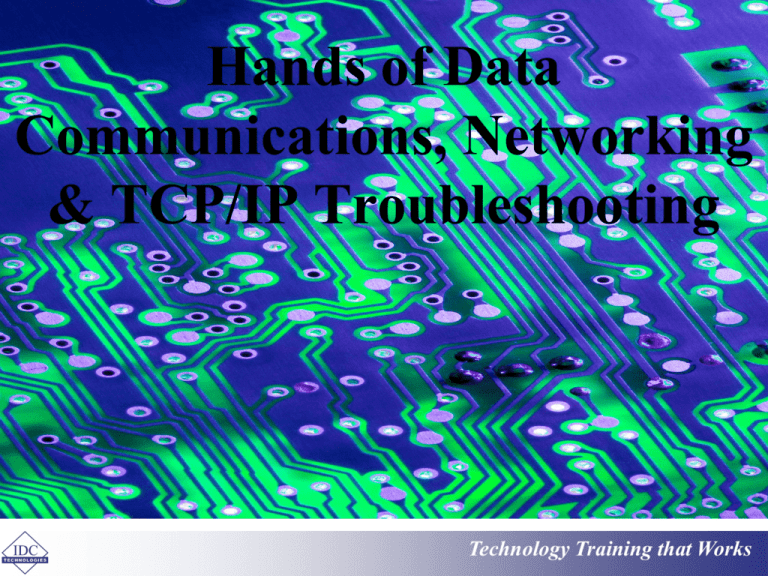
Hands of Data Communications, Networking & TCP/IP Troubleshooting Technology Training that Works Topics Basics of serial communication RS-232 RS-422 RS-485 www.idc-online.com/slideshare Technology Training that Works Serial Communication Data is sent and received one bit at a time over a communication channel. Serial ports 9 pin and 25 pin Used to communicate with terminals and peripheral devices Also known as COM port, controlled by UART www.idc-online.com/slideshare Technology Training that Works Parallel Communication 8 (or 16 or 32) bits are sent and received simultaneously Sent over a bus comprising 8 (or 16 or 32) channels, one for each bit. Usually used within a device. www.idc-online.com/slideshare Technology Training that Works Connector – Types Types of serial port connectors www.idc-online.com/slideshare Technology Training that Works DTE vs. DCE Devices that use serial cables for their communication DTE Data Terminal Equipment E.g. computers, printers Transmits on Pin 2 DCE Data Communications Equipment E.g. modems Transmits on Pin 3 www.idc-online.com/slideshare Technology Training that Works Asynchronous vs. Synchronous Asynchronous No clock sent Level sync Character transfer Susceptible to noise Slow Short lengths www.idc-online.com/slideshare Synchronous Clock sent Edge sync Packet transfer Resistant to noise Fast Long distances Technology Training that Works Serial Communication – Keywords Handshaking - a procedure used to check the link between DTE & DCE before transmitting data Baud Rate Transmission speed Number of bits that are actually being sent over the serial link Type of Cables Modem Cable Null Modem Cables www.idc-online.com/slideshare Technology Training that Works Modem Cable Signal Description 9-pin DTE 25-pin DCE Remarks Carrier Detect (CD) Receive Data (RD) 1 2 8 3 From Modem From Modem Transmit Data (TD) 3 2 From Terminal/Computer Data Terminal Ready (DTR) 4 20 From Terminal/Computer Signal Ground (SG) 5 7 From Modem Data Set Ready (DSR) 6 6 From Modem Request to Send (RTS) 7 4 From Terminal/Computer Clear to Send (CTS) Ring Indicator (RI) 8 9 5 22 From Modem From Modem RS-232 Pinouts DB9 to DB25 www.idc-online.com/slideshare Technology Training that Works Null Modem Cables Signal description 25-pin 25-pin Signal description Receive Data 3 2 Transmit Data Transmit Data 2 3 Receive Data Data Terminal Ready 20 6+8 Data Set Ready + Carrier Detect System Ground 7 7 System Ground Data Set Ready + Carrier Detect 6+8 20 Data Terminal Ready Request to Send 4 5 Clear to Send Clear to Send 5 4 Request to Send Connecting 25 pin to 25 pin for Null Modem www.idc-online.com/slideshare Technology Training that Works Null Modem Cables Signal description 9-pin 9-pin Signal description Receive Data 2 3 Transmit Data Transmit Data 3 2 Receive Data Data Terminal Ready 4 6+1 Data Set Ready + Carrier Detect System Ground 5 5 System Ground Data Set Ready + Carrier Detect 6+1 4 Data Terminal Ready Request to Send 7 8 Clear to Send Clear to Send 8 7 Request to Send Connecting 9 pin to 9 pin for Null modem www.idc-online.com/slideshare Technology Training that Works RS-232 Standard Specifies the method of connection of a DTE and a DCE. A DCE receives data from the DTE and retransmits it to another DCE via a data communications channel such as a telephone link. www.idc-online.com/slideshare Technology Training that Works RS-232 Connections Connection between DTE and DCE using DB-25 connectors www.idc-online.com/slideshare Technology Training that Works Voltage Levels www.idc-online.com/slideshare Technology Training that Works RS-232 Transmitters & Receivers www.idc-online.com/slideshare Technology Training that Works Half Duplex Operational Sequence of RS 232 www.idc-online.com/slideshare Technology Training that Works RS-422 Interface Standard Defines a balanced, or differential, data communications interface Uses two separate wires for each signal Permits very high data rates Minimizes problems with varying ground potentials www.idc-online.com/slideshare Technology Training that Works The EIA-422 Balanced Line Driver Connections www.idc-online.com/slideshare Technology Training that Works EIA 422 Voltages vs. Real Life EIA voltages: ±6 volts to ±2 volts In real systems the voltage is between ±5 volts and ±.2 volts Often the same chips that are used for 485 systems are used for 422 Typical measured voltage is approximately ±2 volts www.idc-online.com/slideshare Technology Training that Works EIA - 422 vs. Real Life Simplex Half or full duplex 10Mbps Differential 10 devices No speed defined Differential Point to point www.idc-online.com/slideshare Technology Training that Works RS-485 Interface Standard Most versatile EIA standard Distances of up to 1200m Data rates of up to 10Mbps 32 line drivers 32 line receivers www.idc-online.com/slideshare Technology Training that Works RS-485 RS-485 is the most common voltage standard in use today for multi-drop communication systems. This is because … It is very resistant to noise It can send data at high speeds And can go long distances www.idc-online.com/slideshare Technology Training that Works Two-Wire Multidrop www.idc-online.com/slideshare Technology Training that Works Four Wire Network www.idc-online.com/slideshare Technology Training that Works DO YOU WANT TO KNOW MORE? If you are interested in further training or information, please visit: http://idc-online.com/slideshare www.idc-online.com/slideshare Technology Training that Works
